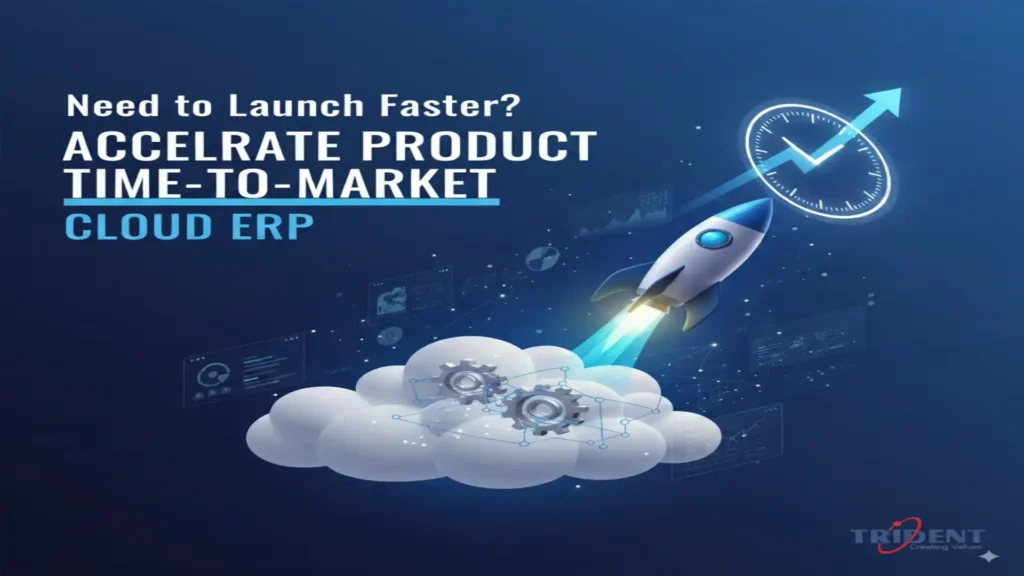Need to Launch Faster? Accelerate Product Time-to-Market with Cloud ERP
Introduction In today’s hyper-competitive world, speed is everything. Businesses no longer compete only on product quality but also on how quickly they can bring those products to market. A delayed launch can mean lost revenue, missed opportunities, and customers moving to faster competitors. So, how can companies launch faster without compromising quality? The answer lies in Cloud ERP. Understanding Time-to-Market What Does Time-to-Market Mean? Time-to-market (TTM) is the period between the conception of a product idea and its availability to customers. In simpler terms, it’s how fast you can move from brainstorming to selling. The Hidden Costs of Being Late Being late doesn’t just cost money—it damages reputation. A missed launch can mean losing early adopters, falling behind competitors, and even reduced investor confidence. Real-Life Examples of Delayed Launches Think of tech giants delaying smartphone launches or pharmaceutical companies waiting too long for regulatory approvals. Those delays often translate into millions of dollars lost. The Traditional Approach to Product Launch Manual Processes and Their Limitations Old-school methods involved spreadsheets, manual approvals, and disconnected departments. These bottlenecks slowed everything down. ERP Before the Cloud Era Traditional ERP systems centralized data but required heavy infrastructure and long deployment times. Why Legacy Systems Hold Businesses Back Legacy systems lack agility, scalability, and speed—three critical factors needed in today’s fast-paced markets. The Rise of Cloud ERP What Is Cloud ERP? Cloud ERP is enterprise resource planning software delivered over the internet. Unlike on-premise systems, it’s hosted on secure servers and accessible anywhere. How It Differs from On-Premise ERP With no heavy hardware investments, faster implementation, and constant updates, cloud Based ERP offers agility that legacy systems can’t match. The Role of Cloud in Modern Business Agility Cloud Enterprise Resource Planning empowers businesses to scale operations, connect remote teams, and make data-driven decisions in real time. How Cloud ERP Accelerates Product Launch Real-Time Data for Faster Decisions Executives no longer wait weeks for reports. Cloud Enterprise Resource Planning provides instant insights, enabling quicker strategic moves. Streamlined Collaboration Across Teams From R&D to marketing, everyone works on the same platform. This eliminates silos and encourages seamless teamwork. Automated Workflows and Reduced Errors By automating approvals and reducing manual input, businesses cut down errors and accelerate processes. Flexible Scalability for Market Demands Need to expand production quickly? Cloud ERP scales instantly without the pain of new infrastructure investments. Key Benefits of Using Cloud ERP for Time-to-Market Real-time data and insights With Cloud ERP, all your product-related data—from design and development to sales and customer feedback—sits in one central place. This real-time visibility means you don’t have to wait weeks for reports. You can spot market shifts, make faster decisions, and adapt quickly when things change. Enhanced collaboration and communication No more silos. Cloud Enterprise Resource Planning gives every team, whether in R&D, manufacturing, or marketing, access to the same updated information. That transparency makes collaboration seamless, improves communication, and cuts down delays across the product lifecycle Streamlined processes and automation Repetitive tasks like inventory management, scheduling, or creating bills of materials are automated. This not only reduces manual errors but also frees up employees to focus on strategic work that truly drives innovation. Scalability and flexibility Need to ramp up production for a new launch? Or scale down during slower seasons? Cloud ERP grows with your business, adjusting resources as needed. That flexibility is a game-changer for companies looking to expand into new markets or launch products quickly. Faster innovation Cloud Enterprise Resource Planning comes equipped with AI, machine learning, and advanced analytics. These tools help you understand customer behavior, identify trends, and design products that resonate with your market. The result? A faster, data-driven innovation cycle. Reduced costs Because it’s cloud-based, you don’t need to pour money into servers or heavy IT maintenance. Your provider handles the infrastructure, so you enjoy predictable costs and lower operational expenses. Improved quality and compliance Cloud ERP keeps track of the entire product lifecycle. From the first design sketch to the final delivery, you’ll have full visibility. This ensures product quality, helps meet regulatory requirements, and reduces the risk of costly recalls—protecting both your brand and your customers. Industries Benefiting from Faster Launches Manufacturing Rapid prototyping, production scaling, and supply chain optimization are easier with cloud ERP. Retail and E-commerce Retailers can track trends and adjust inventories quickly to meet customer demand. Pharmaceuticals and Life Sciences Cloud ERP ensures compliance while accelerating drug development and approval processes. Technology and Startups Startups thrive on speed, and cloud Enterprise Resource Planning gives them the competitive edge they need. Challenges in Adopting Cloud ERP Security Concerns Businesses worry about sensitive data being stored in the cloud. Migration and Integration Issues Migrating from legacy systems can be complex without proper planning. Change Management Employees may resist adapting to new systems without adequate training. Overcoming Challenges Successfully Choosing the Right Vendor Select vendors with strong security, scalability, and proven track records. Training and User Adoption Investing in training ensures teams embrace the new system confidently. Building a Scalable Cloud Roadmap Start small, expand gradually, and align cloud adoption with business growth. Cloud ERP vs. Traditional ERP: Which Wins? Speed of Deployment Cloud Enterprise Resource Planning takes weeks to deploy, while on-premise can take months or even years. Cost Comparison Cloud ERP offers subscription-based pricing, avoiding massive upfront costs. Flexibility and Innovation Cloud systems allow quick updates and innovation, unlike rigid legacy systems. Future of Product Development with Cloud ERP AI and Machine Learning Integration Cloud ERP leverages AI for predictive maintenance, customer insights, and faster R&D. Predictive Analytics for Market Trends Anticipate customer demands and launch products proactively. IoT and Supply Chain Visibility IoT integration ensures real-time monitoring and transparency in global supply chains. Best Practices for Faster Time-to-Market Start Small, Scale Fast Begin with core modules, then expand ERP functions as the business grows. Focus on Cross-Functional Collaboration Encourage collaboration across departments through unified platforms. Embrace Automation and Analytics Automation reduces delays, while analytics provide insights for smarter decisions. How to Choose the
Need to Launch Faster? Accelerate Product Time-to-Market with Cloud ERP Read More »



